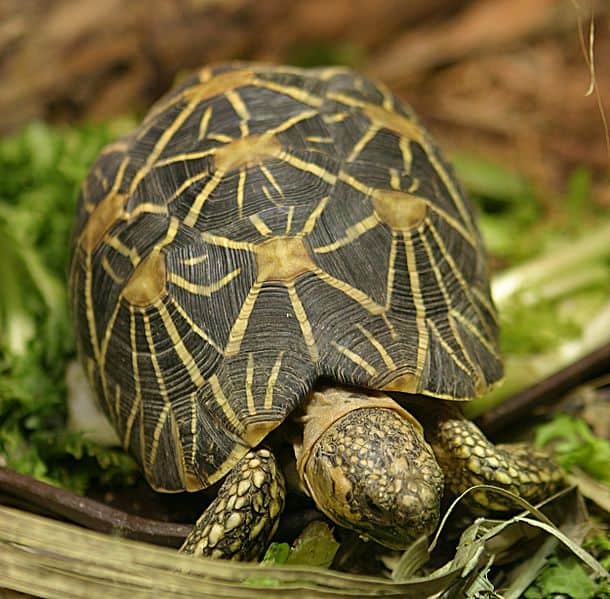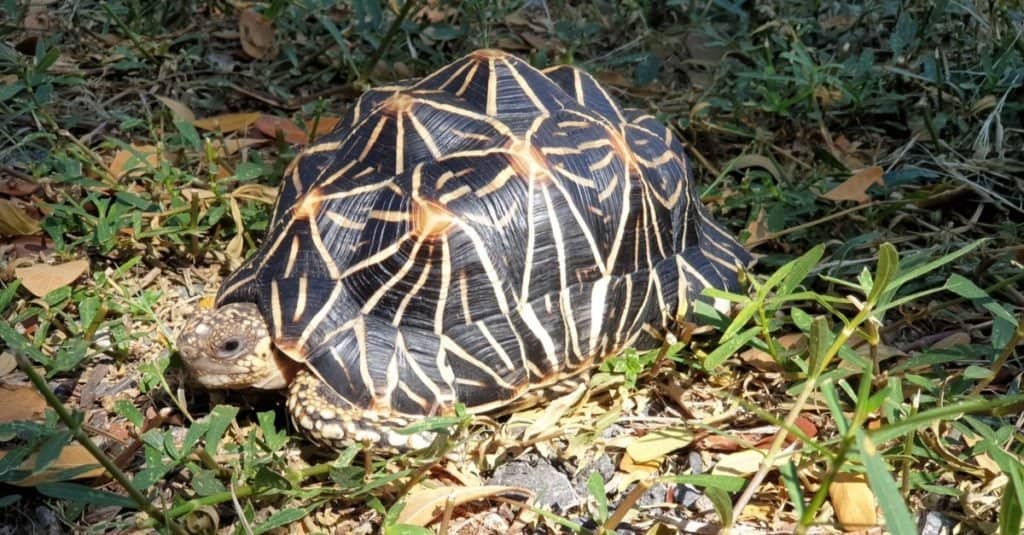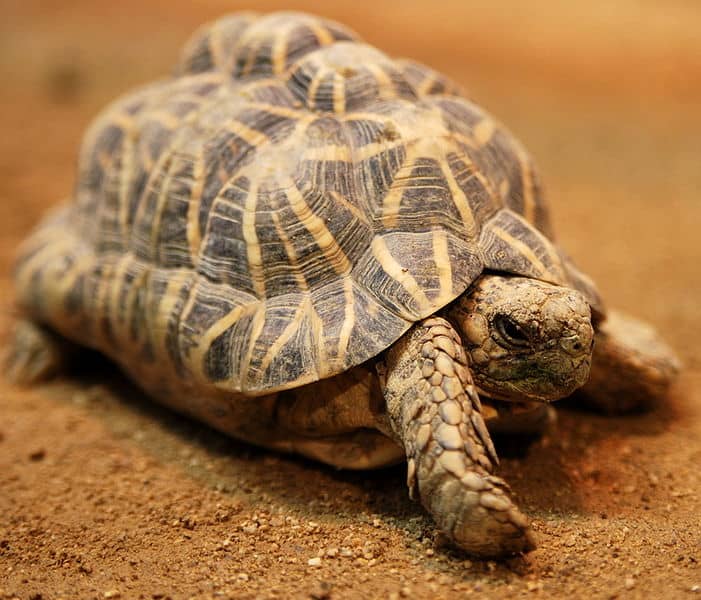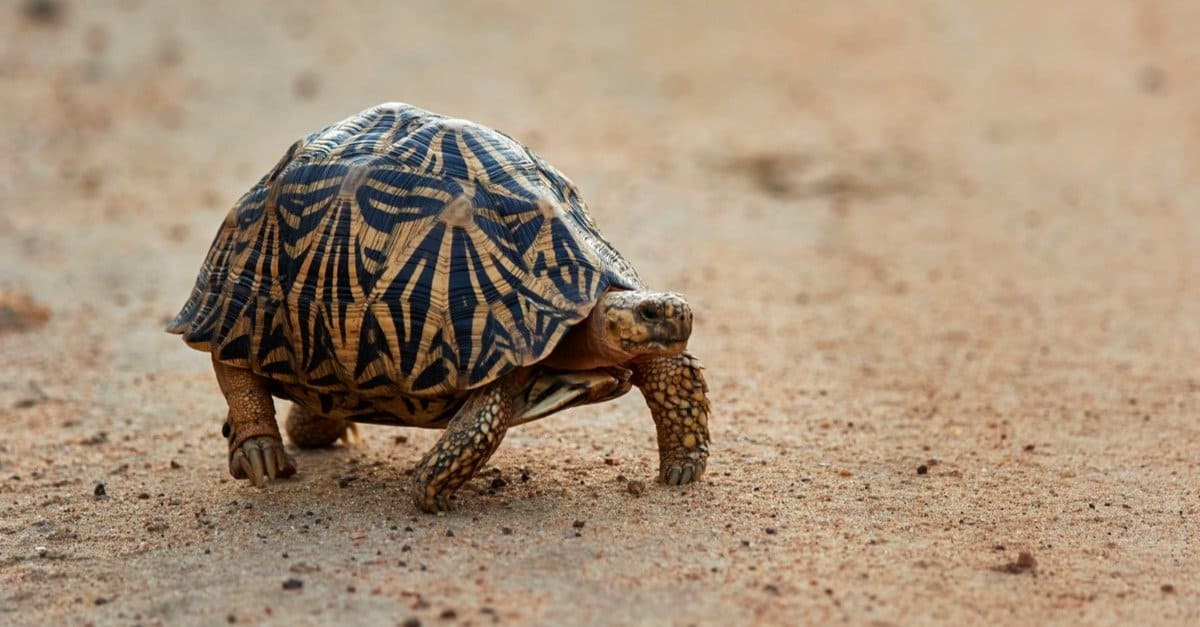Indian Star Tortoise
Geochelone elegans
Popular in the exotic pet trade!
Advertisement
Indian Star Tortoise Scientific Classification
- Kingdom
- Animalia
- Phylum
- Chordata
- Class
- Reptilia
- Order
- Testudines
- Family
- Testudinidae
- Genus
- Geochelone
- Scientific Name
- Geochelone elegans
Read our Complete Guide to Classification of Animals.
Indian Star Tortoise Conservation Status
Indian Star Tortoise Facts
- Lifestyle
- Solitary
- Favorite Food
- Grasses
- Type
- Reptile
- Average Clutch Size
- 7
- Slogan
- Popular in the exotic pet trade!
View all of the Indian Star Tortoise images!
With its unique star-shaped patterns and relatively compact size, the Indian star tortoise is one of the most striking tortoises on the planet.
Found in forests, grasslands, and shrublands across much of India, Pakistan, and Sri Lanka, the species has a high tolerance for seasonally wet or dry habitats and therefore is fairly adaptable. Unfortunately, Indian star tortoises are popular in the international exotic pet trade, and this is primarily why the species is now listed as Vulnerable on the IUCN Red List. Various efforts are in place to protect these tortoises, including the Indian Wildlife Act of 1972.
5 Incredible Indian Star Tortoise Facts!
- Dull Beginnings – Although adult Indian star tortoises are known for their bright, eye-catching patterns, hatchlings are born without distinctive markings. Typically, their shells, or carapaces, are entirely black or brown with rectangular yellow or orange splotches.
- Adaptable – These tortoises do best during the rainy season when they are highly active throughout the day. They also fare well during hot, dry weather, resting under vegetation during the hottest time of day. In cold climates during winter months, they can become inactive for extended periods of time.
- Sexual Dimorphism – Female Indian star tortoises are noticeably larger than males. Males have longer, thicker tails, and the underside of their shell – the plastron – is concave while the females are much flatter.
- Long Living – Like all tortoises, Indian star tortoises have long life spans. On average, they live 35 to 80 years in the wild; in captivity, they live for an average of 25 years.
- No Parental Care – Indian star tortoises provide no post-nesting care. The eggs are laid and then abandoned, and the hatchlings are on their own after they emerge.

History And Origin
It is difficult to find the exact geographic origin of this species because the DNA evidence found is composed of a multitude of tortoise populations. It is known that they originated in India and are part of the larger family of tortoises Testudinidae, which contains 40 to 50 species and 11 genera. The earliest records found are of a fully-shelled turtle Proganocheles that lived in the late Triassic era, over 200 million years ago. The Testudinidae family most likely originate in Asia as well and didn’t begin to migrate to other geographic locations until the Eocene era.
Scientific Name
The scientific name for the Indian star tortoise is Geochelone elegans. This tortoise is just one of two extant members of the genus Geochelone; the other is the Burmese star tortoise, Geochelone platynotan, which is native to Myanmar and is also one of the most endangered tortoises in the world.
The Indian star tortoise belongs to the class Reptilia, the order Testudines, the family Testudinidae and the genus Geochelone.
Types Of
Although the Indian star tortoise is only one of two members of the genus Geochelone, it is considered to be part of three different geological variants.
- northern Indian stars
- southern Indian stars
- Sri Lankan stars
Appearance

Indian Star Tortoise has a striking upper shell that features distinct star patterns.
©Cburnett, CC BY-SA 3.0, via Wikimedia Commons – License
On average, the Indian star tortoise grows to a size of 7 to 12 inches long. Male Indian star tortoises attain an average length of 6 to 8 inches while females attain an average length of 10 to 12 inches. On a size chart comparing all tortoise species, this one would be on the smaller end. The body, limbs, and tail are usually yellow to tan in color, and some dark spots and blotches may be present.
The upper shell, or carapace, of the Indian star tortoise, is its most striking feature. It has an extremely convex, or rounded, shape, with the sides being almost vertical. The dorsal shields, or scutes, often form humps, creating an even more dramatic effect. The scutes can range from being nearly smooth and flat to almost pyramidical in shape. Each one features a yellowish center, which is known as an areola and yellow or tan lines radiate out from there. This creates the distinctive star pattern that lends the tortoise its name. The background – the area below the scutes – is normally brown or black.
The shape of this tortoise’s carapace is believed to be specially adapted to help them return easily to a stable stance after being turned over. This comes in handy since males often compete with each other during mating season by trying to flip each other onto their backs. This self-righting feature ensures that Indian star tortoises aren’t left stranded after being turned over, whether accidentally or otherwise.
This tortoise has a moderate-sized head. The forehead is swollen, convex, and covered with tiny, irregular shields. The tortoise’s beak is slightly hooked. Like

©ZENKY/Shutterstock.com
Males Vs. Females
A high degree of sexual dimorphism is present in Indian star tortoises, making it fairly easy to tell males apart from females. On a size chart, you can easily spot the difference. As noted previously, females are larger than males. They attain an average length of 10 to 12 inches while males grow to an average length of 6 to 8 inches. The plastron, or lower shell, of the female, is fairly flat while the male is much more concave. This feature allows the male to mount the female more easily. Males also have longer, thicker tails than females.
Behavior

Indian Star Tortoises are generally reclusive and solitary.
Indian star tortoises are placid, slow-moving creatures. Outside of the mating season, they tend to be reclusive and solitary. Like most tortoises, they are typically diurnal, meaning that they are awake during the day and asleep during the night. However, some may be considered crepuscular, meaning that they become more active during twilight.
In hot, dry weather, Indian star tortoises are usually active early in the morning and late in the afternoon. The rest of the day, they shelter themselves beneath vegetation or in other hiding places. Their activity increases a lot during the rainy season when they are known to feed and move around throughout much of the day. During the colder, drier winter months, they tend to be less active. Tortoises in colder parts of the range like western India and Pakistan often become inactive for extended periods during the coldest months of the winter. Indian star tortoises have a high tolerance for habitats that go through extreme fluctuations between wet and dry weather.
Habitat

This tortoise can be found dining on fruits, flowers, grasses, and plant leaves mostly in forests, shrublands, and grasslands.
©Tanvi23/Shutterstock.com
The Indian star tortoise’s primary habitats are forests, shrublands, and grasslands and their range extends throughout most of India except for Lower Bengal and west to the Sindh province of Pakistan through to Sri Lanka. Their habitats are mostly found in semi-arid and arid regions. Their extensive range exemplifies the adaptability of this species.
Diet
Primarily herbivores, Indian star tortoises’ diets mostly consist of fallen fruits, flowers, grasses, and the leaves of succulent plants. From time to time, they may opportunistically feed on carrion. Hatchlings subsist off of an embryonic egg sac for the first three to seven days of life.
Predators And Threats

This reptile has few natural predators in the wild but are threatened by human activity.
©Sammara/Shutterstock.com
Thanks to its shell, which it can tuck itself inside of when threatened, the Indian star tortoise has few natural predators in the wild. However, eggs, hatchlings, and juveniles are at greater risk of predation. Common predators include mongoose, hawks, jackals, monitor lizards, snakes, vultures, and foxes.
Humans are also known to prey on these tortoises. Locally, they are often consumed by indigenous groups. On a national and international level, however, these tortoises are not commonly consumed as food.
Although Indian star tortoises don’t have many natural predators, they are threatened on many levels by human activity. Thanks to their distinctive patterns and relatively compact size, they are popularly kept as pets. As a result, they have been extensively hunted for the international pet trade for many decades. It is estimated that 10,000 to 20,000 Indian star tortoises disappear from the wild every year. They are typically sold to middlemen who then sell them to international smugglers. From there, they are sold at markets in places like Thailand and Malaysia and shipped across the world. They can command a price of up to $150 per tortoise, so it’s a lucrative business.
These tortoises are also used in traditional medicine in Malaysia and China, where they are believed to be an excellent source of energy. They also face habitat losses as large expanses of forests and grasslands are cleared for agriculture.
For many decades, efforts have been made to protect Indian star tortoises, whose population numbers are declining. The Indian Wildlife Act of 1972 made it illegal to possess or trade these tortoises, but the law isn’t enforced well, and Indian star tortoises are easy to find for sale in pet shops across India. They are attractive to illegal smugglers because they command such a good price. Under the Convention on International Trade in Endangered Species, or CITES, Appendix I of 2019, all international trade of Indian star tortoises is prohibited. Again, though, enforcing this act is easier said than done.
Reproduction, Babies, And Lifespan

The average lifespan for Indian star tortoises in the wild is 35 to 80 years. In captivity, these tortoises live for an average of 25 years.
Indian star tortoises mate during the rainy season, which occurs from mid-June through November in southern India. During the mating season, males compete for females in displays of aggression, often attempting to flip each other onto their backs. Compared with many other tortoise species, their courtship is fairly subdued, and males rarely shove or nip at females. While copulating, males emit grunt-like sounds.
Approximately 60 to 90 days after mating, the female Indian star tortoise wanders around sniffing the ground in search of a suitable nesting site. After finding one, she urinates to soften the ground and then uses her hind legs to excavate a flask-shaped nest. The female then lays her eggs. In one year, a female Indian star tortoise may lay one to nine clutches, and each clutch may include anywhere from one to 10 eggs. Once the eggs have been laid, the female refills the hole and flattens the earth with her plastron.
Incubation times vary from 90 to 170 days and are probably dependent on temperature. Hatchlings lack these distinctive star markings. Instead, they have black or brown carapaces with rectangular yellow or orange blotches on the scutes. They can grow rapidly for the first several months, but they are on their own from the start because no post-nesting parental care is provided.
Population
Precise figures are not available regarding the total world population of Indian star tortoises. However, their numbers are believed to be declining primarily due to human activity. Anywhere from 10,000 to 20,000 of these tortoises disappear from the wild annually, and around 3,000 of them are recovered from the illegal pet trade through conservation efforts.
In the Zoo
Indian star tortoises are found in zoos around the world. Currently, examples are found at places like the Australia Zoo, the Cincinnati Zoo, and Hogle Zoo in Utah.
View all 39 animals that start with IIndian Star Tortoise FAQs (Frequently Asked Questions)
Are Indian Star Tortoises herbivores, carnivores, or omnivores?
Indian star tortoises are primarily herbivores. Their diets generally consist of fallen fruit, grasses, flowers and succulent leaves. They will also occasionally consume carrion if the opportunity arises, but they don’t necessarily seek it out.
What Kingdom do Indian Star Tortoises belong to?
Indian Star Tortoises belong to the Kingdom Animalia.
What class do Indian Star Tortoises belong to?
Indian Star Tortoises belong to the class Reptilia.
What phylum to Indian Star Tortoises belong to?
Indian Star Tortoises belong to the phylum Chordata.
What family do Indian Star Tortoises belong to?
Indian Star Tortoises belong to the family Testudinidae.
What order do Indian Star Tortoises belong to?
Indian Star Tortoises belong to the order Testudines.
What type of covering do Indian Star Tortoises have?
Indian Star Tortoises are covered in scales.
What genus do Indian Star Tortoises belong to?
Indian Star Tortoises belong to the genus Geochelone.
In what type of habitat do Indian Star Tortoises live?
Indian Star Tortoises live in dry scrub forests.
What is the main prey for Indian Star Tortoises?
Indian Star Tortoises eat grasses, fruits, and flowers.
What are some predators of Indian Star Tortoises?
Predators of Indian Star Tortoises include birds, reptiles, and humans.
What are some distinguishing features of Indian Star Tortoises?
Indian Star Tortoises have high domed, star patterned protective shells.
How many eggs do Indian Star Tortoises lay?
Indian Star Tortoises typically lay 7 eggs.
What is an interesting fact about Indian Star Tortoises?
Indian Star Tortoises are popular in the exotic pet trade!
What is the scientific name for the Indian Star Tortoise?
The scientific name for the Indian Star Tortoise is Geochelone elegans.
What is the lifespan of an Indian Star Tortoise?
Indian Star Tortoises can live for 30 to 80 years.
How big do Indian star tortoises get?
If you refer to a size chart for Indian star tortoises, you’ll notice that males tend to be smaller than females. At full size, an adult male tortoise averages anywhere from 6 to 8 inches in length. Meanwhile, a full size female can grow to a length of 10 to 12 inches.
Are Indian star tortoises good pets?
Indian star tortoises are popular pets, and you can find them for sale across the world. The cost an average price of around $150 per tortoise. Unfortunately, many are illegally obtained from the wild, so it’s important to identify a legal source. Many places in the U.S. and Europe often have captive-bred hatchlings for sale – a much more ethical option.
How fast does the Indian star tortoise grow?
Indian star tortoise hatchlings grow rapidly during the first months of life. They achieve their full size within a year or two. Females reach sexual maturity at 8 to 12 years of age while males reach sexual maturity at 6 to 8 years.
How do you bathe an Indian star tortoise?
To bathe an Indian star tortoise, let it soak in lukewarm water no higher than its armpits. This soaking is important because although these tortoises come from arid and semi-arid parts of the world, they require ongoing hydration. Soaking helps keep the tortoise hydrated, and it loosens up dirt and other debris.
How fast is an Indian Star Tortoise?
An Indian Star Tortoise can travel at speeds of up to 0.3 miles per hour.
How do Indian Star Tortoises have babies?
Indian Star Tortoises lay eggs.
Thank you for reading! Have some feedback for us? Contact the AZ Animals editorial team.
Sources
- Animal Diversity Web, Available here: https://animaldiversity.org/accounts/Geochelone_elegans/
- Britannica, Available here: https://www.britannica.com/animal/tortoise

















